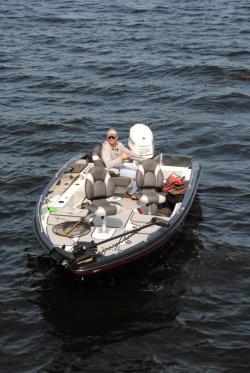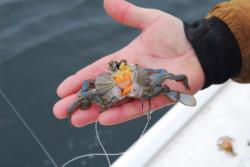Slow Diagnosis Leads to Slower Recovery Since Lyme Disease Is Not Supposed To Be In the Southeast
The Fishing Wire Editor’s Note: We’re cautious when it comes to serious health threats. Our staff knows two people suffering right now from the effects of Lyme Disease because of late diagnosis by doctors who believed “this region doesn’t have Lyme Disease”. Because of that, we’re featuring Alabama Department of Conservation and Natural Resources staffer David Rainer’s report on how a similar reluctance to pronounce a diagnosis of Lyme Disease lead to undue medical suffering. It’s a cautionary tale we hope will increase sensitivity; not create undue concern.
From Ronnie Garrison – I tested positive for Lyme Disease in central Georgia a few years ago and suffered problems for a year before finding a doctor in Alabama that would treat it in a non-standard method.
————-
David Rainer
Alabama Department of Conservation and Natural Resources
Unlike most victims, Chuck Sykes knows exactly when a deer tick bit him that led to a six-month journey through pain, suffering and frustration.
“I was bitten on July 30,” said Sykes, Director of the Alabama Wildlife and Freshwater Fisheries Division. “I knew I’d been bitten. I was looking at some potential rabbit research projects with the dean of Wildlife and Forestry at Auburn University. On the way home, I felt a tick bite me behind my knee. I pulled over to the side of the road and got him off.”
As a lifelong outdoorsman, Sykes said the tick bite didn’t raise any unusual concerns because of previous encounters with the blacklegged tick (aka deer tick).
“I didn’t think anything about it; I’ve been bitten a thousand times,” he said.
But between two and three weeks later, Sykes started having symptoms of the disease named for the area around Lyme, Connecticut, where numerous cases were observed in the 1970s.
“I would walk the dogs at night, and when I would come back in, my hands would be hurting from holding their leash,” he said. “I’d get up in the mornings to get on the treadmill, and my feet were hurting so bad I couldn’t get on the treadmill. I had fatigue and joint paint. Sounds like Lyme disease to me.”
That’s where the frustration started. When Sykes posed that possibility to the first doctor he went to, Sykes said the doctor gave an incredulous look.
“When I told him I thought I had Lyme disease, he had the same reaction that I have when someone tells me they saw a black panther,” Sykes said. “He told me, ‘No, you don’t. We don’t have Lyme disease down here.'”
Sykes then learned that, because he was bitten on the job, he needed to follow a specified protocol for work-related illness or injury in having his illness assessed. The resulting reports from those initial numerous medical exams and extensive blood tests produced no answers on the cause of Sykes’ increasingly debilitating symptoms.
At that point, Sykes decided to turn to specialists recommended by friends. After another round of multiple doctors, with numerous exams and blood tests, various explanations for Sykes’ illness were offered and explored, but none confirmed. Like the initial doctor, none of the medical professionals thought the cause was Lyme disease.
By this time, it was October and Sykes could barely walk. His ankles were swollen and his feet hurt so badly that his gait was substantially impaired. “I was basically shuffling around like I was 90,” Sykes said.
Although a very early Lyme disease test had returned as negative, Sykes had learned that the disease can take an extended time after exposure to show up in testing. Given what he knew of his symptoms and those of Lyme disease, Sykes felt compelled to make certain that was not his problem.
Finally, a coworker told him about a local doctor with a keen interest in Lyme disease. Sykes made an appointment as quickly as possible. The doctor had found a laboratory in California that was at the forefront of the detection of Lyme disease. Sykes pulled $1,500 out of his bank account to pay for the testing that insurance wouldn’t cover.
“Lo and behold, it comes back to the CDC (Centers for Disease Control) as positive for Lyme disease,” Sykes said. “The doctor put me on a cocktail of antibiotics, and within three weeks I was 90 percent back to normal. I will be on antibiotics for another six months, but I’m at least headed in the right direction.”
Sykes said others in Wildlife and Freshwater Fisheries have suffered from Lyme disease, and some haven’t responded as well as he has to the antibiotics.
Recently, I wrote a column on Carrie Mason, a teenager from Wetumpka who was a participant in the Buckmasters Life Hunt who has suffered the debilitating effects of Lyme disease. Mason’s family ran into the same kind of obstacles that Sykes encountered and ended up in Washington, D.C., for treatment.

Also called deer tick
The blacklegged tick is found in most of the eastern United States. The tick can transfer the bacteria that causes Lyme disease, although diagnosis is difficult. Image courtesy of the CDC with permission.
Sykes’ case does not follow the CDC theory that the tick must be attached for 36 to 48 hours for it to transmit the bacteria (Borrelia burgdorferi) that causes Lyme disease.
“I know when I was bitten, and I know when the symptoms started,” he said. “Whether I had been exposed 10 years ago, I don’t know. I know that I didn’t have the symptoms. With this tick bite, I know exactly when the symptoms started.”
The CDC gives guidelines about how to extract a tick to ensure that the head is not left attached to the victim’s skin.
“That one bit me and within 5 minutes I pulled it off,” Sykes said. “I got the whole tick; he was still crawling before I killed him and threw him out the window.”
During his ordeal, Sykes heard about a tick-borne illness seminar at Auburn University that was organized by graduate student Emily Merritt under the guidance of Graeme Lockaby, Dean of Forestry and Wildlife Sciences at Auburn. Funding is being sought for Merritt to conduct a doctorate-level research study in Alabama this year.
Lockaby, who was with Sykes when he was bitten, said Merritt had shown particular interest in tick-borne illnesses because she hails from an area where Lyme disease has the attention of medical professionals.
“Our intention is to do a state-wide assessment of the status of ticks and tick-borne illnesses in the South,” Merritt said. “We’ll be looking at all different tick species and hopefully sample several different pathogens that they might be carrying. First and foremost, we’ll look at Lyme disease, but we’ll also look at Rocky Mountain spotted fever and Southern tick-associated rash illness.
“We’ll take tick samples off wildlife and dogs. We’ll also drag for ticks in likely places. Hopefully, we’ll eventually be able to identify hot spots across the state, areas where people have to be concerned about contact with ticks. We don’t know how bad it is. That’s what we want to figure out.”
Merritt says she doesn’t know why the CDC doesn’t list Lyme disease as a threat in the Southeast because, like Sykes, she knows of numerous people who have been affected by Lyme disease.
“Being from New York, I’m hyper-aware of ticks and tick-borne illnesses,” she said. “Part of the reason that I decided that Auburn should be studying this is I know several foresters, hunters and people who work outdoors who talk about all the people they know who’ve had Lyme disease. It’s scary to hear about it as much down here as I do when I talk to people up north.
“That’s why I think it’s a bigger issue than what we know about it. But it is hard to prove in the lab. So our biggest battle will be to find a sample and confirm it in the lab so we can say, hey, here’s the evidence. Even if the proportion of ticks with the bacteria is not as huge as it is up north, the chances of you getting Lyme can still be great, depending on where you are. The chance is still there even if it’s not as prevalent as it is up north.”
Thoroughly convinced that Lyme disease is a concern for people who enjoy the outdoors in Alabama, Sykes said, “Unlike the black panther stories, I’ve got scientific documentation and proof of Lyme disease that occurred in Alabama.”








